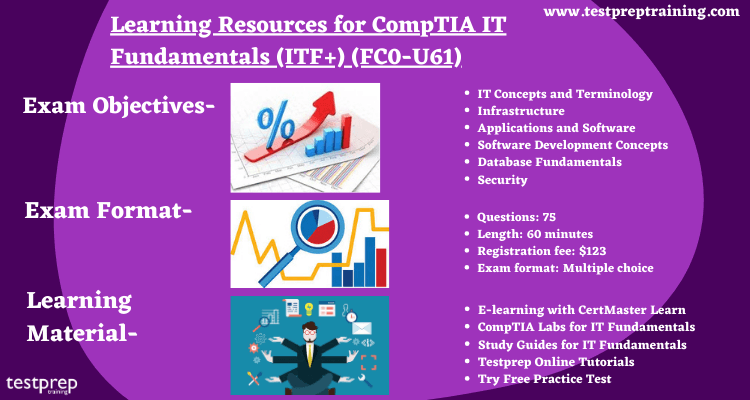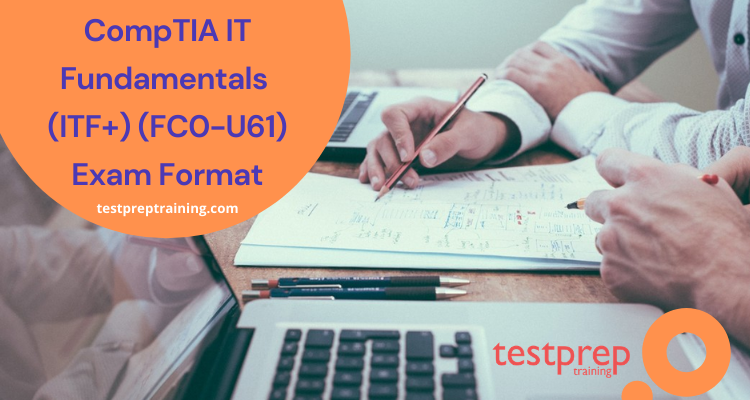Gaining full knowledge about an exam before taking it is a very important step towards completion. Here, we are going to make your day easier by giving you specific information about the CompTIA IT Fundamentals (ITF+) (FC0-U61) exam. We have curated this article specially for the candidates who want to successfully pass the CompTIA IT Fundamentals (ITF+) (FC0-U61) exam. So, let us start with the details. Firstly, the CompTIA ITF+ benefits professionals to determine if a career in IT is best for them or to generate a broader understanding of IT.
- First of all, ITF+ is the only pre-career certification that supports students or career changers to decide if they have competency in information technology and if it is the right occupation route for them.
- Moreover, ITF+ is the only single certification that includes all areas of IT foundations, building a deeper understanding of IT making it ideal for non-technical professionals.
- Also, ITF+ builds an IT education structure for students in middle school and high school.
About the CompTIA IT Fundamentals (ITF+) Exam
Now, let us discuss the important aspects of the CompTIA IT Fundamentals (ITF+) (FC0-U61) exam. The candidate preparing for the exam should know that the CompTIA IT Fundamentals exam primarily concentrates on the fundamental IT skills and knowledge required to execute tasks commonly conducted by advanced end-users and entry-level IT professionals alike, including:
- Firstly, using features and functions of general operating systems and ascertaining network connectivity.
- Secondly, identifying common software applications and their determination.
- Also, managing security and web browsing best practices.
For those who are in doubt if they are ideal candidates for this or not. CompTIA IT Fundamentals (ITF+) (FC0-U61) exam is designed for candidates who are exceptional end-users and/or are acknowledging a career in IT. Also, the examination is also a good fit for individuals involved in pursuing professional-level certifications, such as A+.
Exam Format and Scheduling
The next step should be discussing the format of the exam. So, the CompTIA IT Fundamentals (ITF+) FC0-U61 exam will have a maximum of 75 multiple-choice questions. The candidate will be given 60 minutes to complete the exam. To pass the exam, candidates have to score a minimum of 650 (on a scale of 900). Furthermore, if you are concern about the language then let us clear the doubt, the exam is available in English but for non-English speaking countries.
As with every other exam, you have to pay for this as well, FC0-U61 exam will cost $123 USD and this exam retires usually after three years of launch. Additionally, CompTIA offers two options for taking the FC0-U61 exam: online or in-person. Online testing allows you to conveniently take the certification test from any quiet, distraction-free, and secure location at any time. It offers flexibility in scheduling, allowing you to choose an exam time that suits you, with technical support available in case of any issues during the test. On the other hand, in-person testing provides options at thousands of Pearson VUE test centers worldwide.
To take the CompTIA exam, the candidate can visit Pearson VUE and complete the registration. If a candidate needs to change the exam date, they should reach out to Pearson VUE at least 24 hours before the scheduled appointment. It’s important to note that rescheduling within 24 hours of the appointment or not showing up will lead to the loss of the exam fee.
Course Structure
For clearing the CompTIA IT Fundamentals (ITF+) (FC0-U61) exam, the candidate should know the structure of the exam. Here, we are providing you the course structure for the FC0-U61 exam. Take a look at it:
IT Concepts and Terminology
- Comparing and contrasting notational systems
- Also, contrasting and explaining the fundamental data types and their characteristics
- Describing the basics of computing and processing
- Further, explaining the value of data and information
- Moreover, comparing and explaining common units of measure
- Furthermore, describing the troubleshooting methodology
Infrastructure
- Firstly, classifying common types of input/output device interfaces
- Secondly, provided a scenario to set up and install common peripheral devices to a laptop/PC.
- Explaining the purpose of common internal computing components
- Also, comparing and contrasting common Internet service types
- In addition, contrasting and explaining storage types
- Additionally, comparing and explaining common computing devices and their purposes
- Next, explaining basic networking concepts
- Lastly, scenario to install, configure and secure a basic wireless network
Applications and Software
- Explaining the purpose of operating systems
- Next, comparing and contrasting components of an operating system
- Then, explaining the purpose and proper use of software
- Also, describing methods of application architecture and delivery models
- Providing a scenario to configure and use web browsers
- In addition, contrasting and explaining general application concepts and uses
Software Development Concepts
- Comparing and contrasting programming language categories
- Giving a scenario to use programming organizational techniques and interpret logic
- Explaining the purpose and use of programming concepts
Database Fundamentals
- Describing database concepts and the purpose of a database
- Also, comparing and contrasting various database structures
- Furthermore, summarizing methods used to interface with databases
Security
- Outlining confidentiality, integrity, and availability concerns
- Also, explaining methods to secure devices and best practices
- Not to mention, summarizing behavioral security concepts
- Then, comparing and contrasting authentication, authorization, accounting, and non-repudiation concepts
- Moreover, explaining password best practices
- In addition, describing common uses of encryption
- Lastly, understanding business continuity concepts
CompTIA IT Fundamentals ITF+ Study Guide

- CompTIA Official Website– First of all, you should visit the official website of CompTIA because it offers the most reliable information about the exam. CompTIA provides a study guide for each of its certifications and exams. The CompTIA IT Fundamentals (ITF+) (FC0-U61) course outline is also present on the CompTIA website.
- E-learning with CertMaster Learn: IT Fundamentals– CompTIA gives candidates to have access to the eLearning solution that is CertMaster Learn. CertMaster Learn is interactive and self-paced that includes a customizable learning plan and performance-based questions for IT Fundamentals.
- CompTIA Labs for IT Fundamentals– CompTIA Labs for IT Fundamentals help the candidate to acquire the necessary hands-on skills for your IT Fundamentals certification.
- Study Guides for IT Fundamentals– While studying for the exam, it is good to prefer traditional textbook style learning, which is packed with informative and accessible content covering all IT Fundamentals exam objectives. However, for the ITF+ (FC0-U61) exam CompTIA provides a study guide that is, CompTIA IT Fundamentals FC0-U61 Certification Study Guide.
- Testprep Online Tutorials– CompTIA IT Fundamentals (ITF+) (FC0-U61) Online Tutorial is designed to boost your understanding and provide in-depth knowledge of the exam concepts. These tutorials not only cover exam details and policies but also contribute to strengthening your overall preparation.
- Try Practice Test– Practice tests tests play a crucial role in confirming a candidate’s level of preparation. These tests help candidates identify their weak areas, allowing them to focus on improvement. With numerous practice tests available online, candidates have the flexibility to choose the one that suits them best. At Testprep training, we also provide helpful practice tests for those undergoing preparation.



